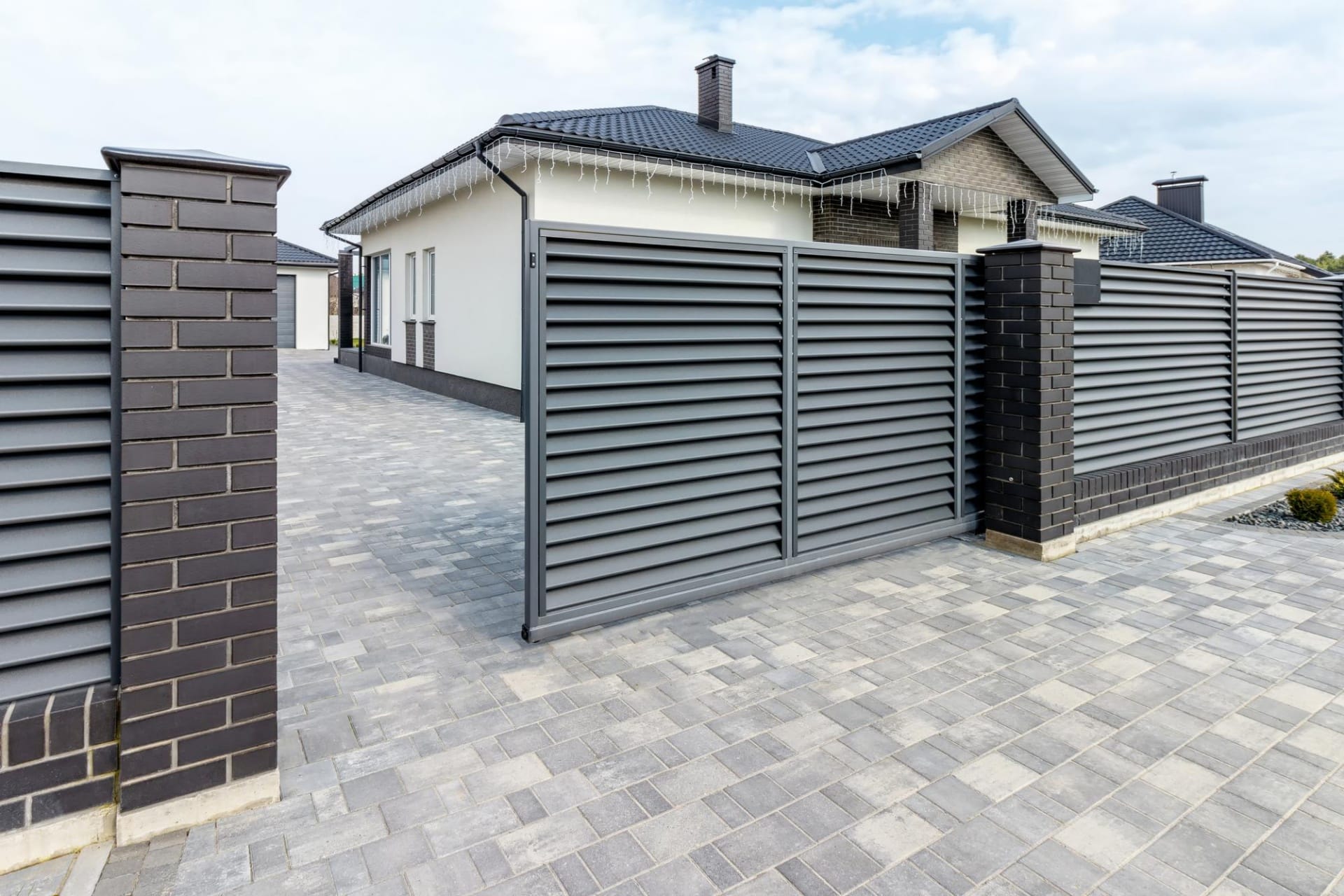Ever wondered how that automatic gate on your neighbours driveway or the boom gates at car parks work? From the old days of manually opening and closing gates, we’ve come a long way with the technology available to every day Australians. Nowadays, with a simple click of a button or even via a sensor, electric gates open up like magic.
In this article, we’ll dig into the nuts and bolts of the humble automatic gate. From the motors that power them to the sensors that detect when to open automatic gates.
Quick Summary
- Automatic gates use a combination of an electric gate motor, opening mechanism, control unit, and transmitter to control the opening and closing of gates.
- The most common types of automatic gates are swing gates and sliding gates. Both types offer convenience and security for residential and commercial properties.
- For more difficult and specific applications there are boom gates, telescopic gates, vertical lift gates, and bi-folding gates. These types of automatic gate are used in areas where there’s limited installation space or difficult terrain.
- There’s an abundance of gate motors on the market available, with each offering its own set of advantages depending on the unique characteristics of the gate.
- For access control, you can choose between robust remote controls, smartphone apps, automatic sensors, and keypads – with or without voice and video interfaces.
- Automated gates provide increased security, look great, and add convenience to both residential & commercial properties.
- Regular gate maintenance is key to extending the life of an automatic gate so that it will work like magic for a decade or more.
Need a gate automated, repaired or installed? Call Gate Gurus on (03) 9052 4903 or Get a Free Quote today.How Do Automatic Gates Work?
Automatic gates operate when the control unit receives a signal from a transmitter – usually a remote or smartphone app. It then activates the gate opener (an electric motor connected to an actuated arm or gear & rack mechanism) to open or close the gate. Electric gates need a power source to operate which comes from mains power or solar power.
But there’s a bit more than that going on behind the scenes. And there are many different styles of automatic gate and options you can fit your gate with. So let’s take a closer look at each component that makes an automatic gate work!
Electric Gate Opener: The Heart of Every Automatic Gate
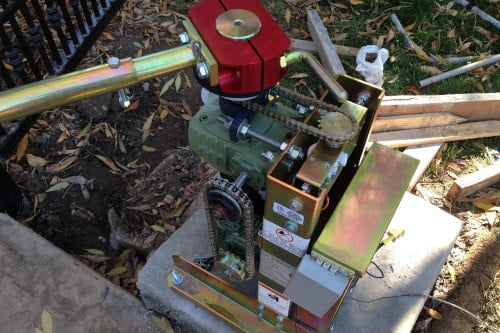
At the heart of every automated electric gate is an opener also known as a gate motor or gate operator. This is the component responsible for the gate’s movement, whether it’s swinging, sliding, or lifting. The gate opener consists of a gate motor and opening mechanism.
The opener receives a signal to activate from a control unit which is housed in a weatherproof box nearby the gate. Depending on the type of electric gate, the motor inside the opener will then power the opening mechanism. For example, an automated sliding gate will have an electric motor that turns a gear that turns a toothed track attached to the bottom of the gate making it slide open or close. A swing gate will have a type of “arm” that opens the gate with the power of the motor.
Modern gate motors are very quiet and efficient so you don’t have to worry about annoying your neighbours! Electric motors don’t have many moving parts and can be expected to last 10 or more years if maintained properly. We go into more detail on each type of gate opener later in the article.
Sensors: The Eyes and Ears of Automatic Gates
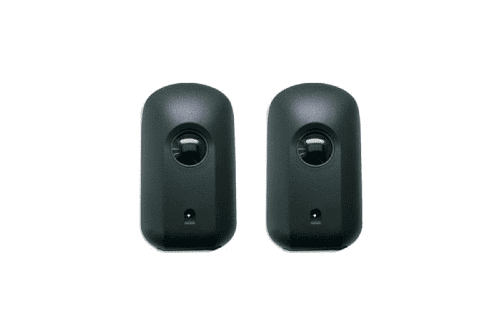
Sensors play a crucial role in the functionality and safety of automatic gates. There are different types of sensors, but their primary job is to detect the presence of vehicles or obstacles. Infrared sensors, for instance, emit beams that when interrupted by a vehicle or person, send a signal to the gate to either open or stop its movement. This not only guarantees easy access but also prevents potential accidents.
Access Control: The Brain Behind the Operation

Playing a vital role in any automated gate setup, the access control systems offer a range of features for secure and remote control of gates. Some key features of access control systems include:
- Intercoms that facilitate communication with visitors
- Wireless technologies that allow for remote gate operation
- Customisable solutions for automatic gate management
In addition to the standard remote operation features, an access control system can incorporate external security options such as keypads, proximity readers, and card readers. These added security measures enable users to grant access only to authorised individuals, further enhancing the safety and security of their property.
Power Supply
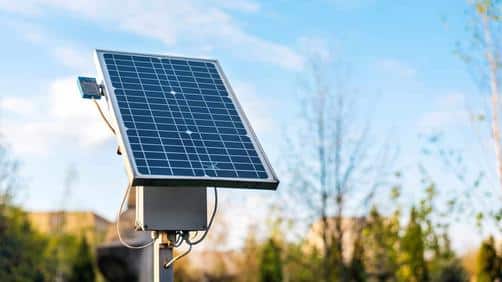
All these components and electronic system require a steady power supply to function. While most automatic gates are connected to the main electrical grid, some also come with solar panel options. For solar panels to be efficient, they requires a space where it will be clear of any trees or buildings that would block sunlight throughout the day. But if your property meets these requirements (find out the advantages and disadvantages of solar gates here), solar is a fantastic option that is both environmentally friendly and will save on your power bills.
Backup Batteries
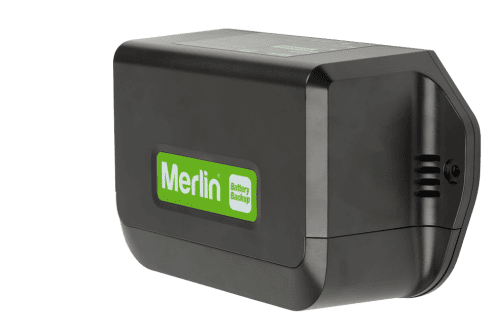
There’s nothing worse than being locked out of your property because an electrical problem has stopped your automatic gate from working. Backup batteries ensure that your automatic gate remains operational even during blackouts. These batteries automatically kick in when the gate operators primary power source is interrupted for added peace of mind. Thankfully most gate openers have a function to allow you to open an electric gate manually.
Need a gate automated, repaired or installed? Call Gate Gurus on (03) 9052 4903 or Get a Free Quote today.Different Types of Automatic Electric Gates
Swing Gates
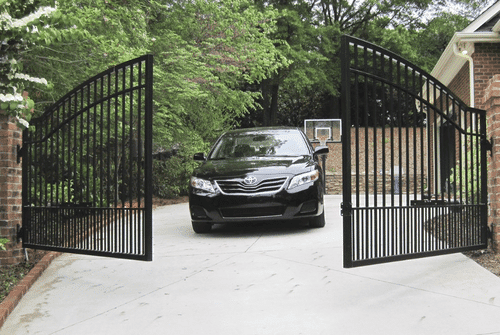
Swing gates are are ideal for properties with ample driveway space and are often chosen for their classic and elegant appearance. They can be single or double, swinging inwards or outwards.
Swing Gates Quick Summary:
- Swing gates rotate on hinges attached to gate posts or pillars, creating a grand and welcoming entrance.
- They are ideal for properties with a large driveway space.
- They can be automated using various motor systems that have their own advantages and disadvantages
- Hydraulic rams use a retractable or extendable arm that attaches to the gate and pillar for operation.
- Articulated arm motors feature a hinged arm that can easily reach around large pillars, making them an ideal choice for gates with substantial posts.
- Underground electric motor systems, though more complex to install, are concealed from sight, providing a more aesthetic solution for gate automation.
Sliding Gates
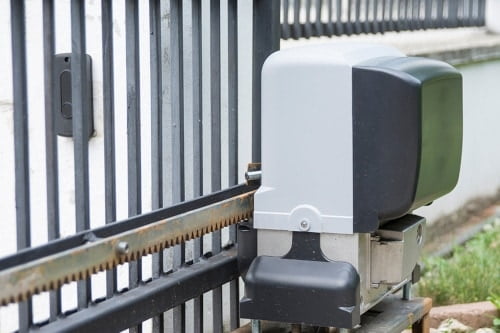
As the name suggests, a sliding gate moves horizontally, usually on a track. They’re especially suited for properties with limited space or steep driveways where swing gates might not be feasible. With their robust design, they offer excellent security and can cover wider entrances.
Quick summary of sliding gates:
- Sliding gates move along tracks installed across the entrance of the driveway.
- Their movement is facilitated by a stationary motor and an external cog.
- The motor’s gear interacts with a toothed rack running along the gate’s length, enabling it to slide open and close smoothly.
- They can handle heavier materials, thus enhancing your property’s overall security.
- They come in various motor systems to accommodate gates of different sizes and weights.
Boom Gates
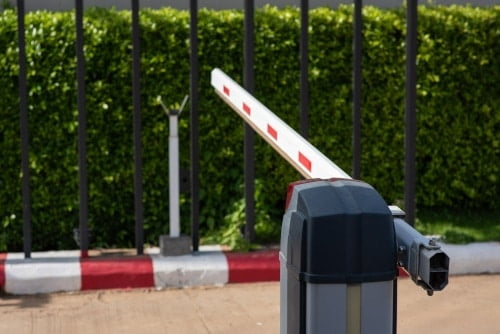
Boom gates are typically seen in parking lots, toll booths, and certain commercial properties. They consist of a pivoting bar or pole that moves up and down. While they don’t offer the same level of security as other automatic gate types, they’re excellent for controlling vehicle access and are quick to operate.
The operation of a boom gate is relatively straightforward. When the gate receives a signal from a remote control, access card reader, or manual switch, the motor activates to lift the boom. Once the vehicle or individual has passed through, the boom is lowered back into place.
Boom gates can be customised with additional features and accessories such as lights and bells to signal operation, or they can be fitted with skirts to prevent pedestrian access underneath the boom.
Telescopic Gates
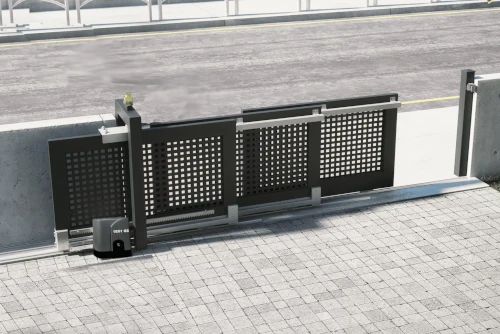
Telescopic gates, also known as cantilever gates, are a type of sliding gate system that is ideal for properties with limited space or uneven terrain. These gates are unique in their operation, utilising multiple gate panels that slide over one another when the gate is opened. This design allows for the gate to fully retract, using less space than a traditional single-panel sliding automatic gate.
The operation of a telescopic gate involves a set of gate panels that slide on individual tracks. When the gate is activated, the first panel moves, followed by the subsequent panels which slide over the first, similar to a telescope extending. This is where the name ‘telescopic gate’ originates.
The automation of telescopic gates requires a specialised electric motor system designed to handle the complex movement of the gate panels. These motors are typically more robust and advanced than those used in standard swing or sliding gates.
Quick summary of telescopic gates:
- They are an excellent solution for properties with limited space.
- They can accommodate wider entrances than traditional single-panel sliding gates.
- They are ideal for uneven or sloping terrain where swing gates are not suitable.
- They provide a high level of security and convenience.
Despite the complexity of their design and operation, telescopic gates offer a practical and efficient solution for automated gate access, especially for properties with specific spatial constraints or unique terrain challenges.
Bi-Folding Gates
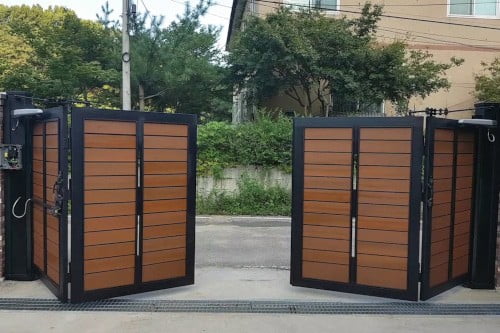
Bi-folding gates, also known as speed gates, are another specialised solution for properties where space is at a premium. Similar to telescopic gates in application, they differ in how they operate. Think of them as the swinging sibling to the sliding telescopic gate.
These gates operate through a unique mechanism where the two gate panels fold onto themselves and then slide to one side. This design enables a wide entrance to be opened or closed quickly, making it a good choice for properties where fast access is a priority, such as busy commercial establishments or residential areas with high traffic.
The automation process for bi-folding gates requires a specific type of electric motor system. This system is engineered to manage the intricate movement of the dual gate panels as they fold and slide simultaneously. These electric motors are generally more powerful and sophisticated compared to those used in standard swing or sliding gates.
Vertical Lift Gates

Vertical lift gates move upwards, lifting entirely above the ground. They’re commonly used in commercial settings, especially in areas with limited side space. These gates are robust, offering high levels of security and are often powered by strong lifting mechanisms.
Quick summary of vertical lift gates:
They are a great solution for properties with limited lateral space or uneven ground surface.
They allow for efficient use of space, making them ideal for commercial premises with limited space.
They provide a high level of security and convenience.
They can accommodate wider entrances than traditional single-panel gates.
Need a gate automated, repaired or installed? Call Gate Gurus on (03) 9052 4903 or Get a Free Quote today.Types of Gate Motors
The smooth and efficient operation of your automated gate system hinges on the selection of the right gate motor. Various electric motors cater to specific gate types, materials, and weights.
Each motor type has its own set of advantages and drawbacks, depending on the type of gate and the specific requirements of your property.
Hydraulic Rams
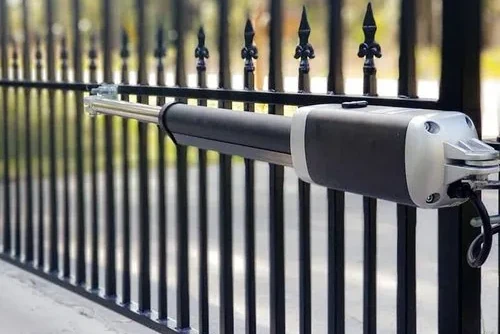
Hydraulic rams are a popular choice for swing gates due to their power and reliability. These motors utilise a retractable or extendable arm that attaches to the gate and pillar, opening and closing the gate with a simple push or pull motion. The arm’s movement is controlled by the flow of hydraulic fluid through the motor, providing consistent and smooth operation.
One of the main advantages of hydraulic systems is their ability to handle heavy gates with ease. This makes them an ideal choice for large, ornate gates that require powerful motors for efficient automation. Additionally, hydraulic systems tend to have fewer moving parts than other motor types, resulting in lower maintenance needs and increased durability.
Articulated Arm Motors
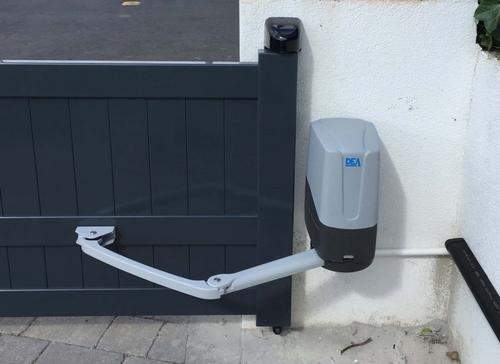
Articulated arm motors are specifically designed for gate automation systems with large pillars. These motors feature a two-part arm connected by an ‘elbow’ joint, allowing for the extension and retraction of the arm to facilitate the smooth opening and closing of the gate. The hinged design of articulated arms enables the arm to reach around wide objects, making it a perfect solution for gates with substantial posts.
In addition to their compatibility with large pillars, articulated arms offer several other benefits:
- They are generally more dependable than other motor types due to having fewer components in motion
- Articulated arms are easier to install than most gate operators and suitable for a wide application of swing gates
- They feature built-in limit switches that enable the setting of open and close positions for the gate
This ensures that the gate will not exceed the established limits when opening or closing, further enhancing the safety and reliability of the automated gate system.
Threaded Shaft Motors
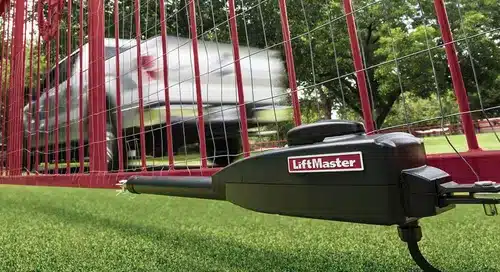
Threaded shaft or linear screw gate motors work by operating a threaded shaft to move the gate mounting along the shaft, thereby enabling the gate to be opened and closed. These motors offer a cost-effective, simple-to-install solution for gate automation, requiring minimal upkeep and maintenance.
However, threaded shaft gate motors may not be suitable for larger gates due to their slower speed and increased power requirements. In cases where a more powerful motor is needed, alternatives such as hydraulic rams or articulated arm motors may provide a better solution.
Nonetheless, threaded shaft gate motors remain a viable option for smaller gates that require a simple, budget-friendly automation solution.
Underground Motors
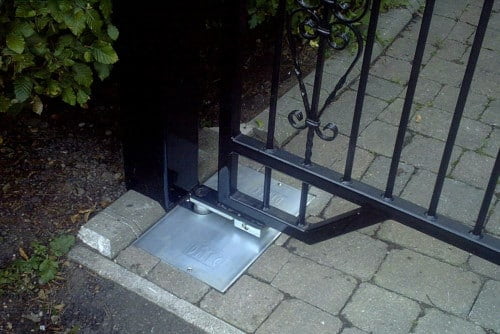
Underground motors offer a discreet and aesthetically pleasing option for gate automation, as they are installed beneath the ground and hidden from view. These motors are typically used to power swing gates, providing a seamless and unobtrusive solution for properties where appearance is a priority.
The installation of underground motors is more complex than other motor types, requiring additional groundwork and time. This includes digging a trench, securing the motor in the trench, and then covering it so that it is hidden. Despite the increased installation effort and cost, underground motors provide an elegant and secure gate automation solution that preserves the visual appeal of your property.
Need a gate automated, repaired or installed? Call Gate Gurus on (03) 9052 4903 or Get a Free Quote today.Access Control Unit and Remote Operation
Today, the operation of automatic gates have significantly advanced beyond the standard 2 button remote control. Modern gates can integrate smart technology and wireless communication and can even be operated from your smartphone to open the gate remotely.
Additionally, modern access control systems can incorporate advanced security features such as biometric identification, including fingerprint scanners and facial recognition. This evolution in automated gate access solutions and gate controls has revolutionised the way we interact with automated gates, offering a blend of convenience, control, and security that was unimaginable a few decades ago.
Remote Controls

The humble remote control is the simplest form of access control. They operate on radio frequencies and send a signal to the gate motor to open or close the gate. There are different types of remote controls available, varying in terms of range, design, and advanced features. Most standard remote controls can operate at a distance of about 30 metres, but there are also high-range remotes available that can work from even further away. You can learn how to program a gate remote here.
Keypads
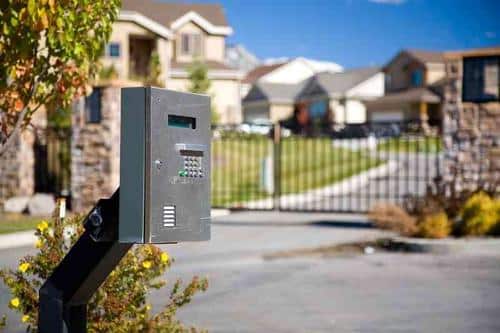
Keypads are another form of access control. They require a person to enter a specific code to operate the gate. This adds an extra layer of security as only those who know the code can operate the gate. Some keypads are even equipped with intercom systems for communication between the gate operator and the person wanting to enter.
Biometric Systems
Biometric systems are the most advanced form of access gate controls. They use unique physical or behavioral characteristics, such as fingerprints, facial recognition, or voice recognition, to verify a person’s identity. This provides a high level of security as it ensures that only authorised individuals can operate the gate.
Smartphone Apps

It’s becoming more popular for automatic gates to be operated using smartphone apps. These apps allow users to both open automatic gates and close the gate remotely, monitor the gate’s status, and even receive notifications when the gate is operated. Here you can read about how I helped a client install a smartphone gate opener
Gate Remote Control Frequencies
The strength and uninterrupted flow of the signal between the transmitter and receiver in the remote operation of automated gates largely rely on gate opener frequencies. In Australia, the majority of gate remotes use the same frequency of 433.92Mhz. This frequency is paired with matching coding technologies, such as rolling code or fixed code, to ensure smooth communication between the transmitter and receiver.
Electric Gate Safety Systems
The motors that power even the smallest electric gate are very powerful! So I always advise to have both physical barriers and electronic safety systems in place to minimise risks and prevent accidents from moving gates.
Physical Barriers
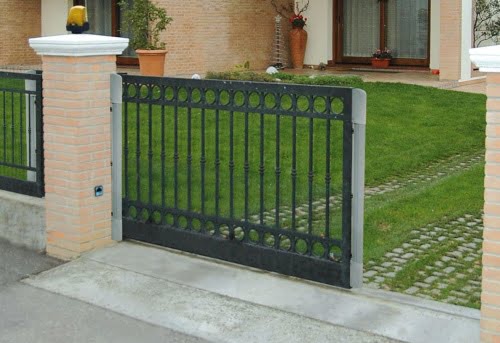
An indispensable part of any automated gate safety system, physical barriers function to restrict access to hazardous areas around the gate during operation. By installing physical barriers around the gate, such as fences or walls or boxes, you can prevent unauthorised access and protect users from coming into contact with moving parts of the electric gate.
Physical barriers can be constructed from a variety of materials, including wood, metal, concrete, and combinations of these materials, such as a chain-link fence with a concrete base. In addition to enhancing security and safety, physical barriers can also help to reduce noise and provide a visible deterrent to potential intruders.
Electronic Safety Features
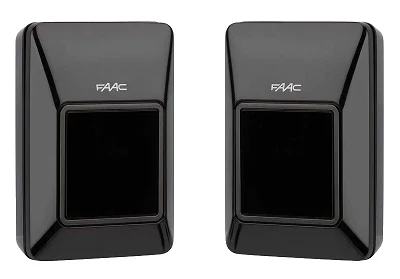
You can take safety up a notch and into the 2020’s with various electronic safety features. Infrared photocells, for example, utilise infrared light to detect the presence of obstructions near the gate. Upon detection, the photocell will activate the electric gate to stop or reverse its motion, preventing accidents and injuries.
Rubber safety edges are another great safety feature to have. They’re installed on the leading edges of moving gates and are designed to detect any obstructions. Whenever the rubberised safety edge comes into contact with anything it will reverse the gate’s movement to prevent potential damage or injury.
Benefits of Automated Gate Systems
By now I hope you can see the many benefits that a quality automated electric gate that has been installed correctly brings to your property. From increased security to aesthetic appeal to the huge increase in convenience, they’re well worth investing in.
And that’s before you even consider the increase in value they bring to your home – they basically pay for themselves! Additionally, these systems can be tailored to complement the style of the property, constructed from a range of materials such as wood, aluminium, iron, steel or composite materials.
With an automated gate system in place, you can enjoy enhanced security, aesthetic appeal, and convenience, making it an invaluable addition to any property.
Need a gate automated, repaired or installed? Call Gate Gurus on (03) 9052 4903 or Get a Free Quote today.Frequently Asked Questions
Can Electric Gates Operate During Power Outages?
Yes, most automatic gates have backup power sources like batteries to ensure the electronic systems and gate control unit continue to function during power outages. The duration for which the gate can operate on backup power depends on the battery capacity and the frequency of gate use.
How Often Do Automatic Gates Require Maintenance?
The frequency of maintenance depends on the type of electric gate and the level of use. It’s generally recommended to service automatic gates at least once a year to ensure they continue to operate smoothly and safely.
Can I Install an Automatic Gate Myself?
While it’s technically possible to install an automatic gate yourself, it’s usually recommended to hire a professional. The installation process can be complex and gate automation requires specific knowledge and tools. Incorrect installation can lead to poor performance, parts breaking, and even accidents.
Do Automatic Gates Increase Property Value?
Yes, automatic gates can increase property value. They enhance security and add a level of sophistication to a property, which can be appealing to potential buyers. And people who can afford to buy properties tend to be older and value the added convenience and security that an electric gate brings.
Can Automatic Gates Be Hacked?
Like any device that uses wireless technology, there is a risk of hacking. However, modern automatic gates use advanced encryption methods that make hacking extremely difficult.
Can I Add an Automatic Opener to My Existing Gate?
Yes, in most cases, an automatic opener can be added to an existing gate. However, the gate must be in good condition and the structure must be strong enough to support the opener.
What Happens if Something is in the Way When the Gate is Closing?
Most automatic gates have safety features like sensors that detect if there is an object in the way when the gate is closing. If an object is detected, the gate will either stop or reverse direction to prevent accidents.
Need a gate automated, repaired or installed? Call Gate Gurus on (03) 9052 4903 or Get a Free Quote today.
